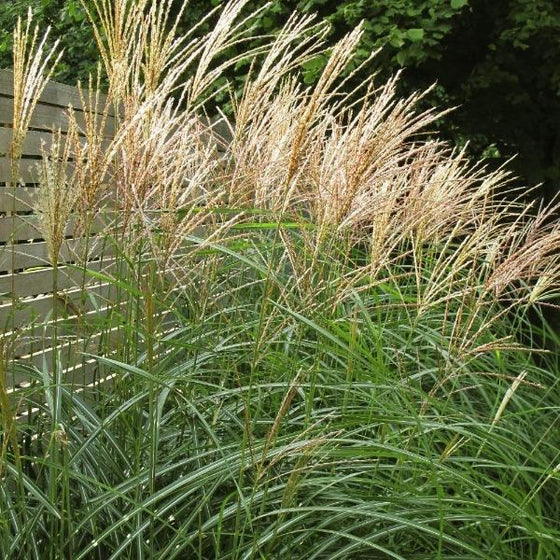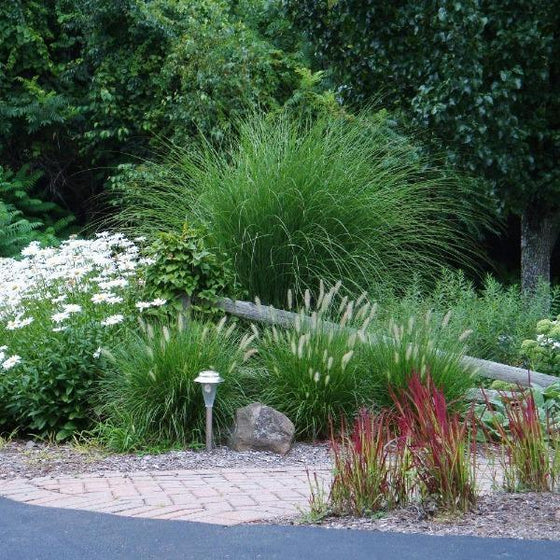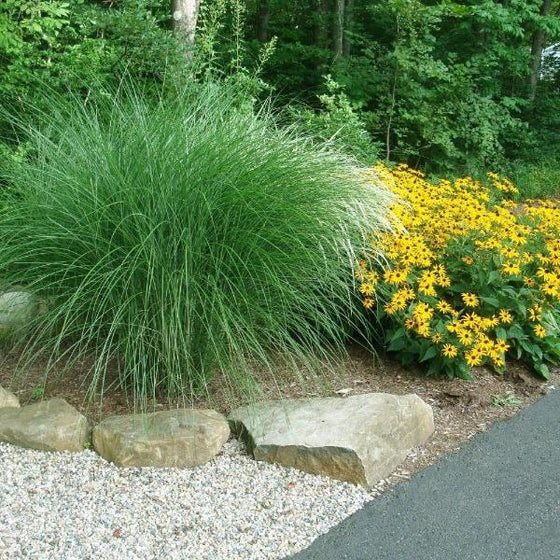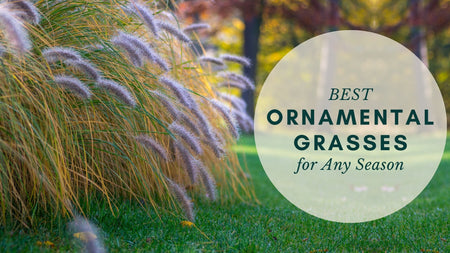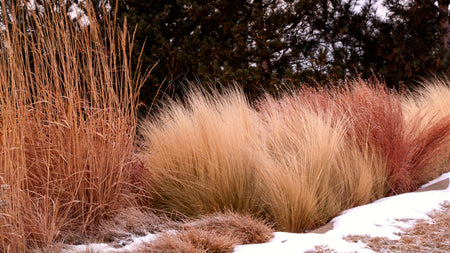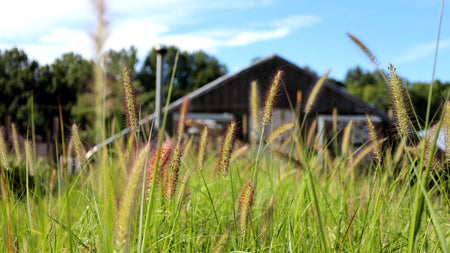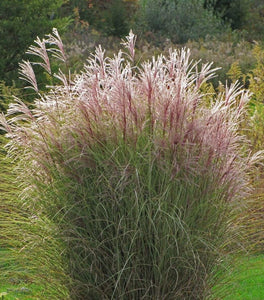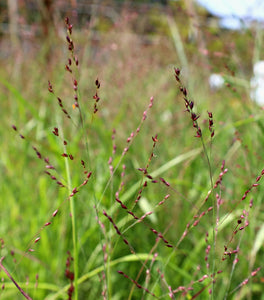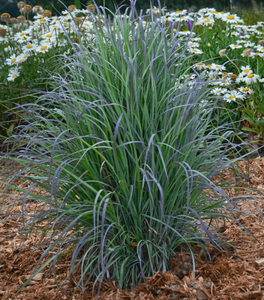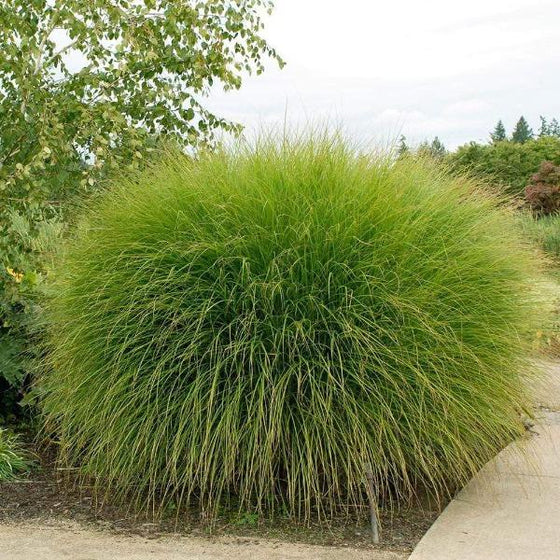
Images Depict Mature Plants
Miscanthus Gracillimus Maiden Grass
Miscanthus sinensis ‘Gracillimus’, also known as Maiden Grass, is a graceful ornamental grass prized for its finely textured foliage and elegant, arching form. This warm-season grass features slender, silvery-green leaves with a prominent white midrib that shimmer in the sunlight and sway gently in the breeze. In late summer to early fall, feathery copper-red plumes emerge above the foliage, maturing to a soft, silvery-white that persists into winter, adding texture and seasonal interest. With a mature height of 5 to 7 feet, Gracillimus brings vertical movement and a soft screen effect to the landscape.
Ideal for foundation plantings, mixed borders, mass plantings, or as a standalone specimen, Miscanthus Gracillimus thrives in full sun and well-drained soil, adapting well to a variety of conditions once established. Its upright, fountain-like habit makes it a stunning backdrop for flowering perennials or as an anchor plant in naturalistic and contemporary garden designs. This ornamental grass is also valued for its drought tolerance, deer resistance, and minimal maintenance needs, making it a go-to choice for low-maintenance landscaping.
Hardy in USDA Zones 5–9, Gracillimus Maiden Grass maintains its structural beauty through all four seasons. In winter, the dried plumes and foliage provide habitat for birds and visual interest in snowy landscapes. Simply cut it back to the ground in late winter or early spring to rejuvenate new growth for the coming season. Whether you’re designing a modern garden or adding texture to a cottage border, Miscanthus Gracillimus delivers seasonal drama, movement, and year-round appeal with ease.
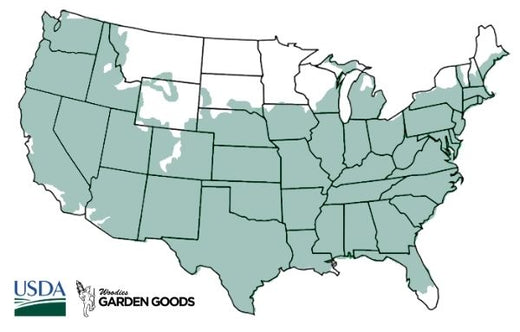
| Hardiness Zone: | 5-9 |
|---|---|
| Mature Height: | 6-7 Feet |
| Mature Width: | 3-4 Feet |
| Sunlight: | Full Sun to Part Sun |
| Water Requirements: | Dry to Evenly Moist |
| Flower: | Copper, Inflorescences |
| Selling Points: | Deer Resistant, Urban Gardening, Coastal Exposure; Natural, Meadow and Cottage Gardens. |
How to Care for Miscanthus Gracillimus Maiden Grass
Be sure to read our planting instructions to ensure a healthy and happy Miscanthus Gracillimus Maiden Grass for years to come!
How do I Plant Miscanthus Gracillimus Maiden Grass?
Planting Miscanthus Gracillimus Maiden Grass begins with selecting a location that offers full sun and well-drained soil, as this ornamental grass thrives in bright light and does not tolerate soggy conditions. Start by digging a hole twice as wide and just as deep as the root ball. Gently loosen the roots if they are compacted, then position the plant in the hole so that the crown sits at or slightly above soil level. Backfill with native soil or a mix of soil and compost, firm it gently, and water thoroughly to eliminate air pockets and help the roots settle in. For multiple plantings, space Miscanthus Gracillimus about 3 to 5 feet apart, allowing room for its mature, arching form. Applying a 2- to 3-inch layer of mulch around the base helps retain moisture, suppress weeds, and insulate the roots. Avoid piling mulch directly against the crown to prevent rot. Once planted, this low-maintenance, deer-resistant grass quickly establishes and brings dramatic vertical texture, movement, and four-season interest to borders, privacy screens, and naturalized areas.
How do I Water Miscanthus Gracillimus Maiden Grass?
Watering Miscanthus Gracillimus Maiden Grass correctly is crucial, especially during its first growing season when the roots are establishing. After planting, provide a deep watering two to three times per week, ensuring that the soil stays consistently moist but not waterlogged. Focus watering at the base to encourage deep root growth and prevent fungal diseases on the foliage. Well-drained soil is key—standing water can lead to root rot. Once established, Miscanthus Gracillimus becomes drought-tolerant, requiring less frequent watering, particularly in cooler months or during periods of consistent rainfall. During hot and dry spells, especially in the heat of summer, check soil moisture regularly and increase watering as needed to prevent stress. A 2–3 inch layer of mulch around the base of the grass will help conserve soil moisture and reduce evaporation. Avoid overhead watering, which can encourage mildew and rust on the leaves. With proper watering, this low-maintenance ornamental grass rewards you with lush, arching foliage and beautiful, airy plumes that bring dynamic movement and visual interest to your garden throughout the seasons.
How do I Fertilize Miscanthus Gracillimus Maiden Grass?
Fertilizing Miscanthus Gracillimus Maiden Grass helps encourage lush foliage and robust growth, particularly during the active growing season. In early spring, as new growth emerges, apply a balanced slow-release fertilizer such as 10-10-10 or 14-14-14 around the base of the plant, taking care to keep it a few inches away from the crown. This initial feeding supports healthy leaf and plume development throughout the summer months. For an organic approach, compost or well-aged manure can be mixed into the topsoil to provide long-lasting nutrients while improving soil structure. Avoid over-fertilizing, as excessive nitrogen can lead to floppy growth and diminished plume production. In nutrient-poor soils, a light second feeding in mid-summer can be beneficial, but in most garden settings, a single spring application is sufficient. Miscanthus Gracillimus is a low-maintenance ornamental grass that doesn't require heavy feeding to thrive. With the right fertilization routine, this stunning grass will reward you with graceful arching blades, tall feathery plumes, and reliable four-season beauty in borders, screens, and mass plantings.

How and When should I Prune Miscanthus Gracillimus Maiden Grass?
Pruning Miscanthus Gracillimus Maiden Grass is essential for maintaining its graceful form and promoting healthy new growth each season. The best time to prune is in late winter to early spring, just before fresh shoots begin to emerge. Use sharp pruners or hedge shears to cut the entire clump down to 4–6 inches above the ground, removing all of the previous year’s foliage and dried seed plumes. This cleanup not only improves the plant’s appearance but also encourages a fuller, more uniform habit as it regrows. Avoid pruning in the fall, as the dried foliage and plumes add striking texture and movement to the winter landscape, and also provide shelter for beneficial insects. If left untrimmed too long into spring, the new growth can become tangled in the old blades, making it harder to prune cleanly. Regular annual pruning helps keep Miscanthus Gracillimus looking its best and supports its long-term health, ensuring a dramatic display of arching leaves and feathery plumes from summer into winter.
Additional Information
Maiden Grass is an ideal choice for creating texture and movement in landscaping, especially because it offers visual interest for all four seasons. These plants grow up to 7 feet tall so they make a great option to create subtle privacy (expect for early spring when they're cut back). Miscanthus Gracillimus (Maiden Grass, Eulalia Grass, Chinese Silver Grass) makes a great backdrop for perennial flowerbeds. Plant them in full sun areas, and try to position them so that they are backlit by either the sunset or sunrise in your area, you won't regret it.
If you are going for a naturalistic landscape you can pair your grasses with Salvia, Lavender, Coneflower, Bottlebrush, and Midwinter fire Dogwood Shrubs - these will all complement each other in style and still create interest in multiple seasons. For a more cottage garden look, match these with landscaping roses and flowering shrubs such as Deutzia or Weigela.
Maiden Grass is deer and rabbit resistant, but it will attract birds to your garden. In east Asia where this grass is native, it is common to control Gracillimus by letting goats, sheep, horses and cattle graze on it. Here in North America, deer and other native animals did not co-evolve with Miscanthus Gracillimus, so they are not interested in eating it. However, horses, cattle, sheep, goats and other livestock often did co-evolve with this grass; letting them graze on it is a common solution for controlling the spread of Chinese Silver Grass.
If you live further south, and your frosts don't curb the spread of Maiden Grass the way that you would like, then there are some native options that might work well for you. Native alternatives for ornamental grasses include Switchgrass or Little Bluestem.

